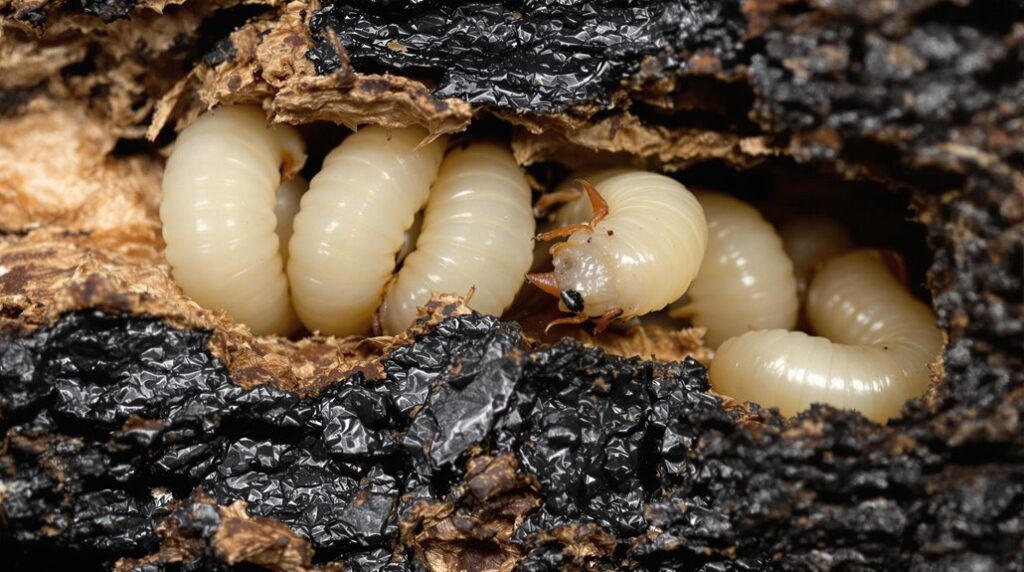To feed your Hercules beetle larvae, provide them with a nutritious substrate of well-decayed hardwood and leaf litter. You can supplement their diet with soy protein powder, dog food pellets, or specialized products like Beetle Boost. Maintain a moist environment with 60-70% humidity and a temperature range of 22-25°C. Regularly monitor and mix the substrate to prevent mold growth and maintain ideal conditions. As the larvae progress through their instars, they’ll require continuous feeding and ample space to develop. Keep reading to discover more about the fascinating world of Hercules beetle larvae and how to help them thrive.
Natural Diet
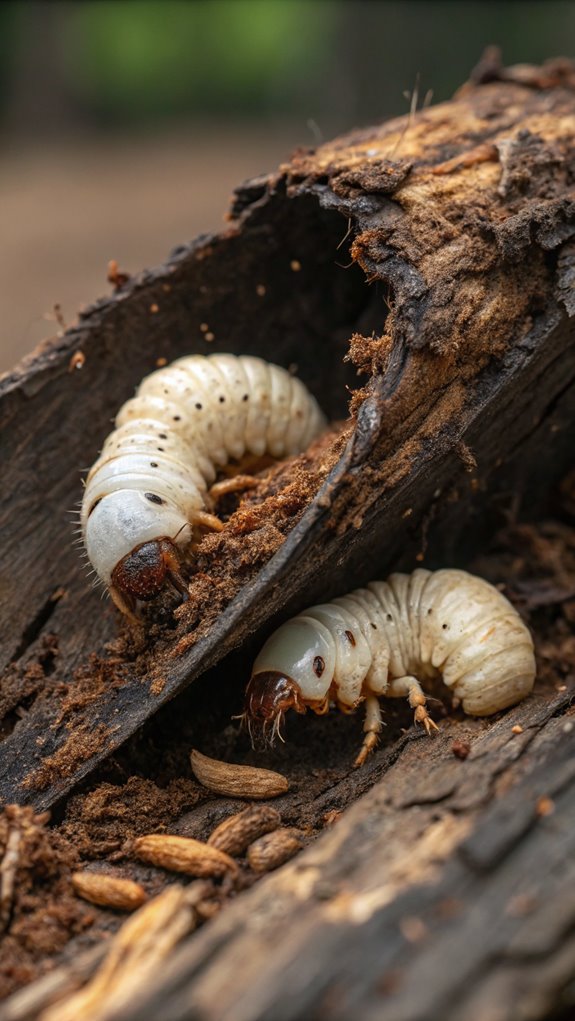
Hercules beetle larvae have a natural diet that consists primarily of rotting wood. It’s their primary food source in the wild. They also consume dead leaves and other decaying plant matter to supplement their diet.
You’ll find the larvae residing in hardwood stumps and fallen trees of sufficient size to support their large stature. The girth of these decaying logs is important, as the larvae need substantial food sources to fuel their growth over their two-year developmental stage.
While rotting wood is favored due to its high nutritional value, the larvae aren’t picky eaters. They’ll feed continuously on any decaying wood they encounter. This saproxylophagous feeding behavior plays an essential role in biodegradation and nutrient cycling within their habitats. Studies on phenotypic assimilation under specific introgression conditions facilitate an understanding of adaptive traits and their roles in different environments.
In the absence of predators, the larvae can feed uninterrupted, aiding the decomposition process and contributing to overall ecosystem health. Tropical rainforests, with their abundance of fallen trees and rich undergrowth, provide ideal feeding grounds.
It’s worth noting that the quality and quantity of their food directly affect larval size and development. A stable supply of white-rotten hardwood is critical for their survival in the wild.
As they mature into adults, Hercules beetles may expand their dietary preferences to include rotting fruits found among the undergrowth.
However, throughout their lengthy larval stage, rotting wood remains the cornerstone of their natural diet, enabling them to grow into the impressive giants they’re known to be.
Nutritional Substitutes
While rotting wood serves as the primary food source for Hercules beetle larvae in their natural habitats, captive breeding environments often require nutritional substitutes to guarantee their healthy development.
You can use alternative substrates like kinshi, fermented wood flakes, decayed leaf substrate, and advanced substrate mixes tailored to the specific needs of different beetle species. Gradually introduce new substrates to avoid disrupting larval development.
Synthetic additives can also support larval growth and health. Soy protein powder and dog food pellets are recommended as dietary supplements, especially in later stages of development. Beetle Boost, a shrimp-based supplement, can further enhance larval growth. However, be cautious with supplements to prevent mold and maintain larval health.
Cellulose, nitrogen, and high protein diets are essential components for larval growth, provided by fermented wood flake substrates and protein supplements.
Maintain a balanced substrate mix of decayed leaves and wood, and control humidity to prevent dehydration and maintain ideal substrate moisture.
Implement effective feeding strategies, such as mixing food with substrate, regular feeding, and monitoring and adjusting as needed. Larval frass can also be mixed back into the substrate to enhance its nutritional value.
Careful selection of substrates and supplements is vital to avoid toxic materials like conifer and pine, which can harm larvae.
Feeding Methods
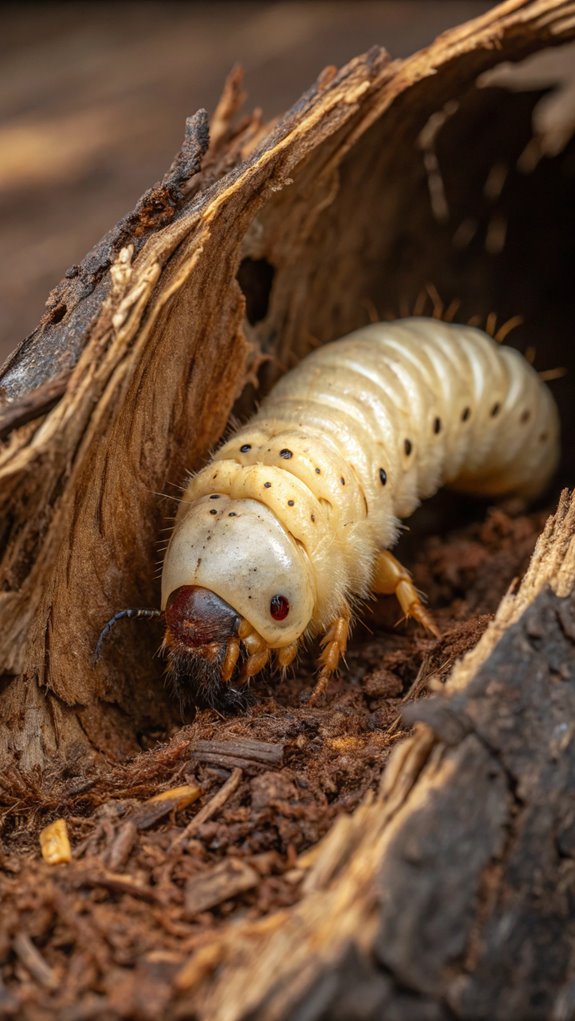
To guarantee your Hercules beetle larvae receive the nutrition they need, you must employ effective feeding methods. You’ll want to provide them with rotting wood that’s rich in moisture and nutrients. They’re equipped with specialized mouthparts designed to break down wood fibers, so make sure there’s an ample supply available.
You should let your larvae consume the wood over an extended period. They’ll adjust their feeding based on the availability of suitable wood sources. Under ideal conditions, they can eat continuously, allowing them to grow considerably during this developmental stage. Larval feeding aids in nutrient recycling within the ecosystem as they consume decaying organic matter.
When selecting food sources for your larvae, prioritize fallen trees from tropical rainforests or decaying deciduous trees like ash. Ensure the wood is sufficiently moist and nutritious to support their growth.
Keep in mind that they require specific environmental conditions to thrive, including high humidity and temperature. You’ll need to provide adequate space for your larvae to grow, as they can reach impressive lengths of up to 4.5 inches.
Be aware that the presence of predators can influence their feeding behavior, so take steps to protect them. Monitor environmental changes that could impact the availability of their food sources.
Feeding Frequency
You’ll need to pay close attention to the feeding frequency of your Hercules beetle larvae throughout their development. The larval stage lasts 12-18 months in the wild, divided into several instars, each with specific feeding needs. Continuous feeding is vital during this stage, but you’ll need to adjust based on the larvae’s size and development.
Environmental factors like temperature and humidity greatly influence feeding behavior. You must guarantee a constant supply of suitable decaying wood, as it’s essential for the larvae’s growth. Be aware of potential predators that can affect feeding frequency by threatening the larvae’s survival.
The first instar (L1) lasts about 50 days, with larvae feeding continuously on the available substrate. A 16 oz container filled with substrate, including hard wood and protein, is provided for the larvae’s growth and development. The second instar (L2) spans 56 days, and you’ll notice more intensive feeding as the larvae prepare for the next moult.
The third instar (L3) is the longest at 450 days, requiring extensive feeding to maximize growth before pupation. Expect reduced feeding during pre-pupation and no feeding during the 32-day pupal stage.
Captive-bred populations and laboratory studies provide valuable insights into feeding frequency and patterns under controlled conditions. Wild observations highlight the importance of decaying wood in the larvae’s natural habitat.
Confirm you meet the specific nutritional requirements for ideal growth and development. Finally, be mindful of predation threats that may influence the larvae’s feeding frequency.
Optimal Temperature
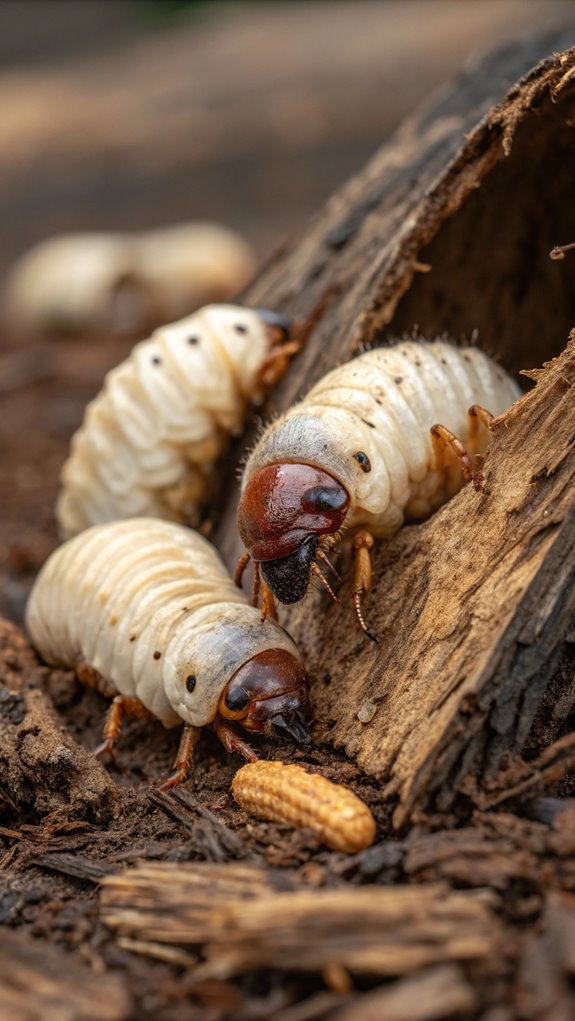
Maintaining ideal temperature is fundamental for the healthy development of Hercules beetle larvae. You’ll want to keep the temperature range between 22-25°C, which is optimal for their growth. Temperature affects the duration of larval stages, so it’s critical to guarantee proper conditions throughout their development.
While Hercules beetles can adapt to various temperatures, they perform best within this specified range. Temperature control is especially important during hot summers and cold winters to simulate natural conditions. Lowland species like Dynastes hercules require warmer temperatures compared to highland species, so keep that in mind when setting up their environment.
Each larval stage (L1, L2, L3) requires precise temperature control, as does the pupation phase and egg incubation. To maintain ideal temperatures, consider using panel heaters with thermostats in enclosures. In hot climates, air conditioners may be necessary to keep temperatures stable.
Digital thermometers are fundamental for accurate monitoring, and styrofoam cooler boxes with air holes can provide insulation. Place enclosures in quiet, shaded areas to help stabilize internal temperatures. When breeding Hercules beetles, keep adults at optimal temperatures before and during mating.
Females need consistent temperatures above 22°C to lay eggs successfully, and temperature affects the duration and success rate of egg hatching. Consistent temperatures are essential for larval development and eventual adult emergence, and they also impact the lifespan of both larvae and adult beetles. Proper humus moisture is also crucial for maintaining the health and survival of Hercules beetle larvae.
Humidity Requirements
Hercules beetle larvae thrive in environments with consistent humidity levels between 60-70%. You’ll need to monitor humidity regularly to maintain ideal levels. Lower humidity can lead to desiccation and death, while higher humidity promotes mold growth and disease.
To control humidity, add water to the substrate in moderation. You want the substrate moist but not waterlogged. When squeezed, it should form a ball without water seeping out. Over-saturation is detrimental.
Humidity requirements remain consistent throughout larval stages and into the pupal stage, which lasts 2-3 months. Pupal chambers also require controlled humidity to prevent desiccation. Failure to maintain humidity can result in deformed adults.
Incorrect humidity leads to various developmental issues. Low humidity causes larval desiccation and death, while high humidity encourages mold and disease. Inconsistent humidity produces deformed adults.
Maintaining ideal humidity is critical for healthy larval development and successful metamorphosis. Use water application judiciously to keep the substrate appropriately moist. The larval stage lasts 10-13 months for females and 12-20 months for males.
You’ll want to check humidity levels frequently, making adjustments as needed. Don’t let the substrate dry out or become overly wet. Hercules beetle larvae are sensitive to humidity fluctuations, so you must be diligent in your monitoring and maintenance.
With proper humidity control, you’ll create an environment conducive to robust larval growth and development. Remember, consistency is key. Avoid drastic changes in humidity levels, and your Hercules beetle larvae will thrive.
Substrate Preparation
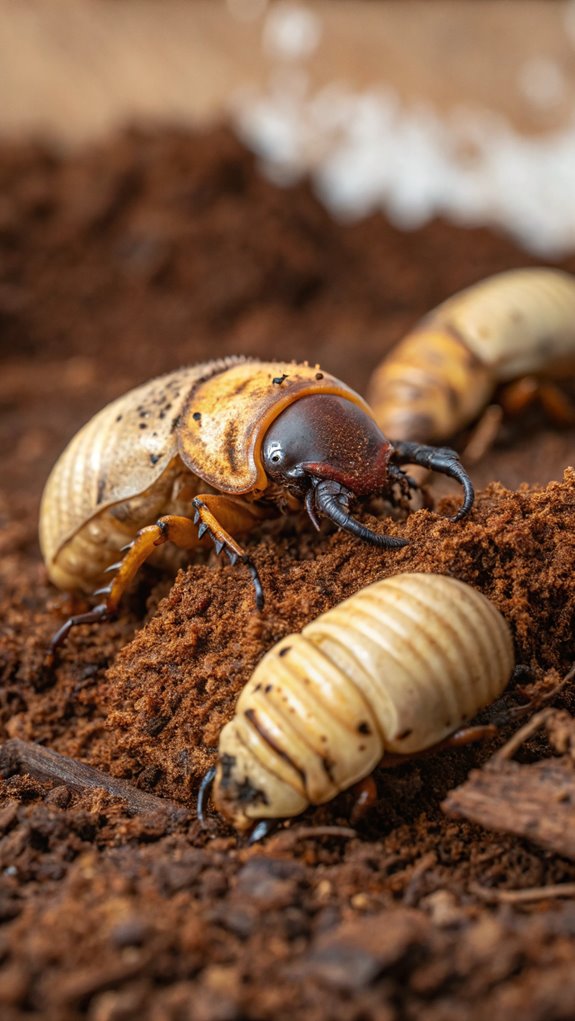
Proper substrate preparation is just as important as humidity control for the successful rearing of Hercules beetle larvae. You’ll need to source well-decayed leaf litter and wood, ideally at least a year old, from woodland areas beneath hardwood trees. Avoid using freshly fallen leaves or undecayed wood, as they lack the necessary nutritional content for larval growth.
When collecting substrate materials, focus on the layers beneath the freshly fallen leaves. Crumbly and visibly decayed materials are ideal for larval nutrition. You can allow the materials to ferment outdoors in ventilated spaces to enhance microbial activity. Gradually introduce new substrates to the larvae to prevent shock.
Different substrate types cater to various beetle species. Leaf litter substrate suits Cetoniinae beetles, while decayed wood substrate is ideal for Dynastinae and Lucanidae. Flake soil, a fermented wood flake substrate, benefits various species. Kinshi substrate and stag beetle grade are tailored for specific beetle needs.
Maintain the substrate by regularly sifting out frass to prevent contamination. You can mix old substrate with new to maintain beneficial microbial communities.
Monitor the substrate to guarantee it remains moist and free from ammonia or alcohol odors. Store substrates in well-ventilated spaces to prevent fungal growth.

Erzsebet Frey (Eli Frey) is an ecologist and online entrepreneur with a Master of Science in Ecology from the University of Belgrade. Originally from Serbia, she has lived in Sri Lanka since 2017. Eli has worked internationally in countries like Oman, Brazil, Germany, and Sri Lanka. In 2018, she expanded into SEO and blogging, completing courses from UC Davis and Edinburgh. Eli has founded multiple websites focused on biology, ecology, environmental science, sustainable and simple living, and outdoor activities. She enjoys creating nature and simple living videos on YouTube and participates in speleology, diving, and hiking.
🌿 Explore the Wild Side!
Discover eBooks, guides, templates and stylish wildlife-themed T-shirts, notebooks, scrunchies, bandanas, and tote bags. Perfect for nature lovers and wildlife enthusiasts!
Visit My Shop →
